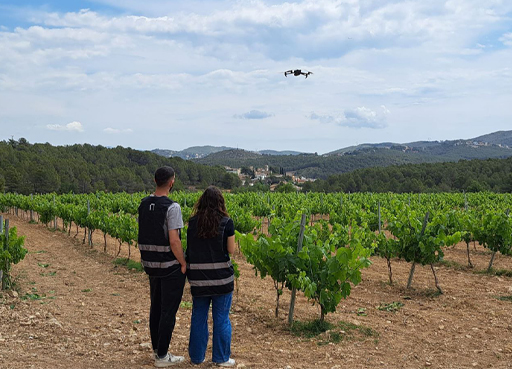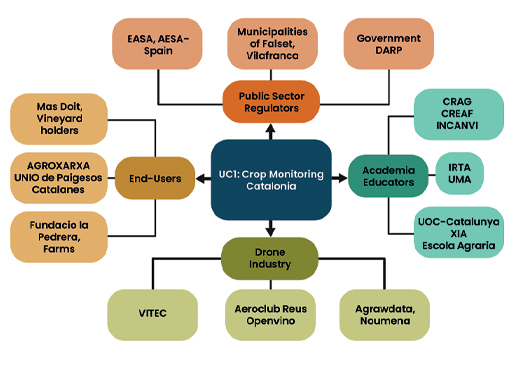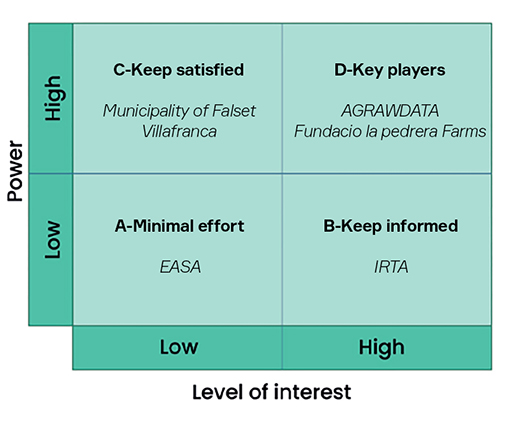4.3 Using drones for crop health assessment
Located in Barcelona, Spain, Noumena is a leading technology company specialising in the study and analysis of spatial dynamics with a focus on spatial analytic models and machine learning, novel data collection and management processes and emergent technologies, including remote sensing and computer vision. In 2022, Noumena started its development of a crop monitoring and vineyard disease detection research project funded through the European ICAERUS programme, which serves as one of five primary ICAERUS use cases.
The project is being carried out in the vineyards of Mas Martinet farm in Priorat of the Tarragona region of Spain, where the fertile Catalan mountains meet the coastal plains stretching out to the Mediterranean. The region is a major wine-producing area in Catalonia and accounts for a significant percentage of the regional and national food industry sector.
The overall aim of the project is to facilitate and support the use of organic agricultural methods through the use of drone-based data collection, monitoring and crop health management. Drone imaging feeds into a crop management dashboard to monitor and assess field data and organic crop management techniques. There has been a resurgence in organic viticulture in the region, with Mas Martinet farm leading in new techniques. Organic vintners need to have high quality data to meet organic standards, as well as to ensure the ongoing health of their crops.
The project has many different stakeholders, including data operators and software developers, agrarian universities and research institutes, including educators, drone manufacturers and other industry operators, farmers, vineyard holders and agricultural associations, public sector regulators and public authorities of Catalonia, and indeed the final customers purchasing the wine. Figure 18 shows a mapping of the stakeholders of the project.
While many different actors and organisations play a role in the project, it is useful to consider the main stakeholder groupings within the power versus interest matrix. Using stakeholder data collected for the ICAERUS programme, you can map five example members into the matrix.
AGRAWDATA is a Noumena partner responsible for the development and deployment of agricultural geographic and GIS data, as well as decision support systems to assist farmers. They aim to collaborate with partners and end users (farmers) in order to build a market for their data analytics products and enhance science and knowledge in technological precision farming techniques. They are also in need of a skilled workforce to deploy emerging technologies. As they are a major partner in the project, with ties to both the suppliers of the technology and its users, they exert a great deal of influence (power) in the project and have a high level of interest in its success. You can therefore map them as a ‘Key Player’ in the project.
The Municipality of Falset, Villafranca is the municipal authority that governs the local area where the project is taking place. They are very interested in the project, particularly with respect to public safety and opinions, and are keen to understand its outcomes for potential policy impacts. While they exert a great deal of power in terms of regulatory oversight, their interest is mainly general given the broader scope of their activities. You thus map them to the ‘Keep Satisfied’ quadrant.
Fundacio La Pedrera Farms is a large agricultural association founded by the largest landowner in the area. Its interest is to promote best practices, agricultural employment and skills and conservation programmes in Catalonia. The association often collaborates in large government projects to train farmers and coordinates large-scale transition programmes. They, too, are a major partner in the project with key connections across the public and agricultural sectors, including end users and agricultural customers. You thus map them to the ‘Key Players’ in quadrant D.
The Institute for Agrifood Research and Technology (IRTA) is an academic institution sponsored by the Catalonian government. They support and coordinate between the public and private sectors to promote research and technological development in the agrifood industry. They are able to provide important data, including air traffic data and have a general interest in the project (although do not specifically resource it). They have a high level of interest in the project due to their mission, but do not exert a high level of influence over it. You map them to the ‘Keep Informed’ quadrant.
The European Aviation Safety Agency (EASA) is an EU-level government body responsible for civil aviation safety. It coordinates with member state agencies (e.g. at country level) to ensure the safety of drone operations and advises on safety regulations. While regulatory compliance is an essential aspect of the project, interactions with the EASA are minimal on a day-to-day basis. In this case, you place them in the ‘Minimal Effort’ category.
The stakeholders for your business idea are likely to fall within some of these larger categories or groups – customers, investors, employees, business partners, regulators, suppliers, etc. Mapping their power and interest will help you to see which stakeholders to prioritise and, as noted earlier, which ones might have competing interests. In the final activity of this week, you’ll identify the stakeholders of your business idea and map their power and interest.
Activity 4
Consider the idea you have developed in Activity 2 and identify your stakeholders. List these possible stakeholders, dividing them between external and internal
Now, using this PowerPoint slide [Tip: hold Ctrl and click a link to open it in a new tab. (Hide tip)] , identify where in the power and interest matrix your stakeholders lie.
.png)


